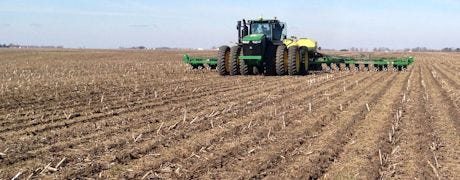
For many growers, the terms conservation and profitability are on opposite ends of the spectrum.
Yet, John Werries and son Dean prove that these two goals can coexist on the same farm. In fact, they argue, the concepts are synergistic.
The Werries first pushed into conservation farming with no-till. After several delayed planting seasons, they moved to strip-till in 1996. At first, they were strip tilling soybean stubble for corn planting. In the late 1990s, they started experimenting with strip till in a corn-on-corn system. Of course, this was without RTK in those days.

Each year, the Werries move the strip over three inches. This alleviates compaction as they’re never driving on the actual strip. RTK allows them to maintain extreme accuracy.
In the early years, it was all about strip placement. John notes they started by strip-tilling between the rows to avoid the previous year's root mass.
Today, they're strip-tilling continuous corn on about 3,500 acres and no-tilling 300 acres of soybeans. With the help of RTK, they place the strip three inches from the previous year's crop. Every other year's corn rows are in the same strip.
Instead of float tires, they have gone to duals on the combine and narrow triples on the strip-till tractor.
"Since the rows are never driven on, we don't have to use stalk stompers or worry about tire damage," John explains. "It makes for easier pulling and better looking strips."
Corn harvest ended Nov. 1, 2014. Cover crops were planted by Nov. 3, 2014. Their strips were made while applying anhydrous ammonia in mid-November. That schedule involved three operators running the strip-till bar 24/7 for eight days straight.
"The way we're managing our farm, we couldn't do this without RTK," Dean adds. "When they said RTK reduces stress and lets you run a longer day, they weren't kidding."
Adding cover crops >>
~~~PAGE_BREAK_HERE~~~
The Werries are a perfect example of leveraging technology to provide maximum benefit for the environment and the bottom line.
Once the strips are in following harvest, they begin seeding cover crops with an air seeder to help soak up nutrients and keep soil in place. John is also experimenting with aerial applied cover crop seed. As time went on, he saw the benefits of nutrient sequestration, bio tillage and increased organic matter.
Thinking about a cover crop? Start with developing a plan. Download the FREE Cover Crops: Best Management Practices report today, and get the information you need to tailor a cover crop program to your needs.
Most experts advise easing into cover crops. After the Werries seeded 40 acres to cover crops in 2011, they went all out the following year. The past three years, all 3,800 acres have been seeded to cover crops.
"The way I look at it, I've only got a certain number of crops left," John notes. "So, I've got to do the best I can with our land."
That decision paid dividends in 2013. Following the drought of 2012, John noted 9.6 inches of rain in May 2013. Thanks to a robust stand of cereal ryegrass (or annual ryegress depending on planting date), the bulk of leftover nutrients stayed in place.
Five N apps
The final piece of the Werries' conservation crop management system was an overhaul of their nutrient management plan. Until 10 years ago, John and Dean were applying more than 200 pounds of anhydrous ammonia in one shot each fall.
They started splitting the nitrogen application up with a pop-up application. Soon after, they added weed and feed to the program. Three years ago, they started side-dressing everything that was practical – avoiding the extreme slopes where they cannot keep the toolbar off the row.
Today, they're applying an average of 250 pounds of N each season, split over five applications: DAP (custom applied), fall anhydrous ammonia, pop-up, weed and feed, and sidedress. The DAP and anhydrous ammonia are applied using variable rate technology.
"We are not skimping on N by any means," John says. "But, we are feeding that crop slowly throughout the year."
Their average corn yield for 2013 was 234 bushels. In 2014, they averaged 245.5 bushels over the 3,500 acres of corn.
- Flint is editor of Farm Futures' sister publication Prairie Farmer
About the Author(s)
You May Also Like




